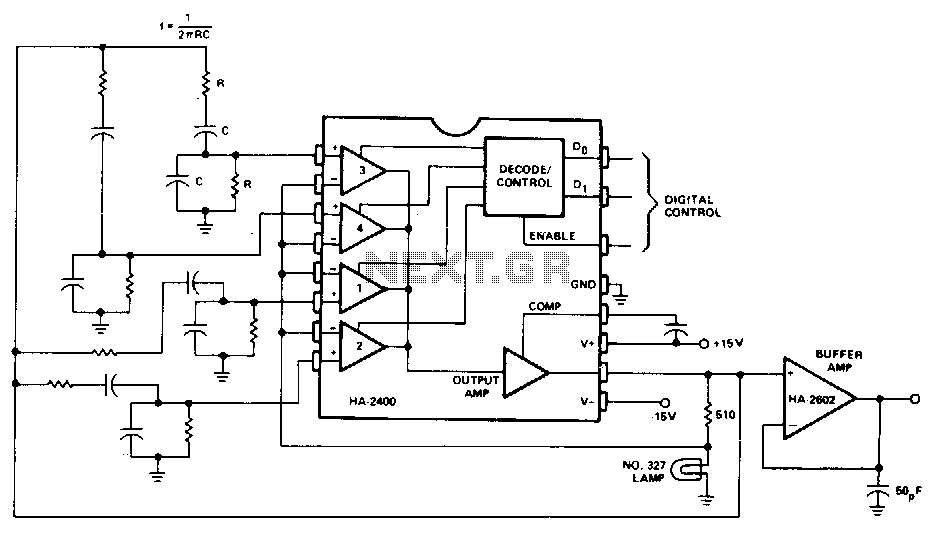
Programmable-frequency-sine-wave-oscillator

A Wien-bridge oscillator can be made variable by utilizing two frequency-determining components that are adjusted simultaneously with high tracking accuracy. However, high-quality tracking potentiometers or variable capacitors are often costly and challenging to procure. To circumvent the need for such components, this oscillator is designed to function with a single potentiometer. Additionally, with preset P2, the overall amplification can be adjusted so that the output signal maintains a reasonably stable amplitude of up to 3.5 Vpp across the entire frequency range. The specified components enable the frequency to be adjusted between 350 Hz and 3.5 kHz.
The Wien-bridge oscillator is a type of electronic oscillator that generates sine waves. It is based on the Wien network, which consists of a combination of resistors and capacitors configured in a bridge circuit. The variable frequency operation of this oscillator allows for fine-tuning of the output signal, making it suitable for various applications in signal generation and testing.
In this design, the single potentiometer serves as a variable resistor that modifies the bridge’s balance, thus changing the frequency of oscillation. The use of a single control element simplifies the circuit design and reduces costs, addressing the challenges associated with acquiring high-quality dual potentiometers or capacitors.
The preset P2 is critical for maintaining a stable output amplitude, which is essential for reliable operation across the specified frequency range. By adjusting this preset, the user can ensure that the output signal does not exceed 3.5 Vpp, thus preventing distortion and maintaining signal integrity.
The frequency adjustment capability of the oscillator, spanning from 350 Hz to 3.5 kHz, makes it versatile for various applications, including audio testing, signal processing, and educational demonstrations. This range allows the oscillator to be effectively used in both low-frequency and moderate-frequency scenarios, catering to a wide array of experimental and practical electronic applications.
In summary, this Wien-bridge oscillator design leverages a single potentiometer for frequency adjustment while ensuring stable output amplitude through careful amplification control. The resulting circuit is both cost-effective and functional, making it a valuable tool for electronic experimentation and development.A Wien-bridge oscillator can be made Vllriable by using two frequency-determining parts that are varied simultaneously at high tracking accuracy. High-quality tracking potentiometers or variable capacitors are, however, expensive and difficult to obtain.
To avoid having to use such a component, this oscillator was designed to operate with a single potentiometer. With preset P2 you can adjust the overall amplification so that the output -signal has a reasonably stable amplitude, 3.5 Vpp max., over the entire frequency range. The stated components allow the frequency to be adjusted between 350 Hz and 3.5 kHz. 🔗 External reference
The Wien-bridge oscillator is a type of electronic oscillator that generates sine waves. It is based on the Wien network, which consists of a combination of resistors and capacitors configured in a bridge circuit. The variable frequency operation of this oscillator allows for fine-tuning of the output signal, making it suitable for various applications in signal generation and testing.
In this design, the single potentiometer serves as a variable resistor that modifies the bridge’s balance, thus changing the frequency of oscillation. The use of a single control element simplifies the circuit design and reduces costs, addressing the challenges associated with acquiring high-quality dual potentiometers or capacitors.
The preset P2 is critical for maintaining a stable output amplitude, which is essential for reliable operation across the specified frequency range. By adjusting this preset, the user can ensure that the output signal does not exceed 3.5 Vpp, thus preventing distortion and maintaining signal integrity.
The frequency adjustment capability of the oscillator, spanning from 350 Hz to 3.5 kHz, makes it versatile for various applications, including audio testing, signal processing, and educational demonstrations. This range allows the oscillator to be effectively used in both low-frequency and moderate-frequency scenarios, catering to a wide array of experimental and practical electronic applications.
In summary, this Wien-bridge oscillator design leverages a single potentiometer for frequency adjustment while ensuring stable output amplitude through careful amplification control. The resulting circuit is both cost-effective and functional, making it a valuable tool for electronic experimentation and development.A Wien-bridge oscillator can be made Vllriable by using two frequency-determining parts that are varied simultaneously at high tracking accuracy. High-quality tracking potentiometers or variable capacitors are, however, expensive and difficult to obtain.
To avoid having to use such a component, this oscillator was designed to operate with a single potentiometer. With preset P2 you can adjust the overall amplification so that the output -signal has a reasonably stable amplitude, 3.5 Vpp max., over the entire frequency range. The stated components allow the frequency to be adjusted between 350 Hz and 3.5 kHz. 🔗 External reference